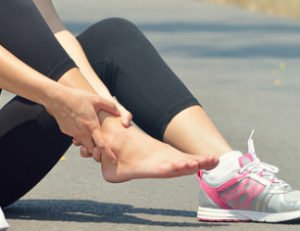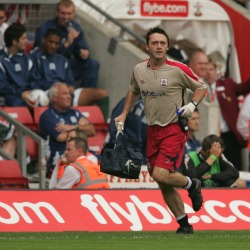A sprain is an injury to the band of a ligament – this is a specialised connective tissue, which connects two or more bones to a joint. The primary function of a ligament is to provide passive stabilisation of a joint and it plays an important role in proprioceptive function. A sprain is usually caused by the joint being forced suddenly outside its usual range of movement and the fibres are stretched through too great a range. For example, excessive inversion of the ankle can cause the lateral ankle ligament sprains, normally the anterior talofibular ligament, to rupture. A ligament rupture can occur at the mid-substance of the ligament or at the ligament-bone junction. Sometimes an avulsion fracture also occurs (the ligament pulls a piece of bone with it on injury).
Grades of Injury
A sprain can range from mild (tearing of just a few fibres) to severe (complete rupture of the ligament, leading to joint instability). The severity of a sprain is graded according to how badly the ligament has been damaged and whether or not the joint has been made unstable.
- Grade I – structural damage only on microscopic level, with slight local tenderness and without joint instability.
- Grade II – partial tear (rupture) of the ligament, visible swelling and noticeable tenderness, but without joint instability (or with mild instability).
- Grade III – a severe sprain: complete rupture of the ligament with significant swelling and with instability of the joint.
Ligaments are organised into groups of fibre bundles. The fibres are similar to tendons but ligaments have more elastin, they are high in proprioceptive fibres.
TREATMENT
Phillip has developed the most efficient methods possible to treat ligaments. Years of study and work on elite athletes enabled him to become an expert on effective treatment and rehabilitation for everyone.
Twyford Clinic Physiotherapy treatments include:
- Prevention of abnormal scar tissue formation, joint stiffness, muscle weakness
- Restore proprioception (balance and joint position control).
- Pain relief through joint mobility techniques, soft tissue massage or frictions.
- Improving scar tissue quality using techniques to guide the direction it forms.
- Loosening or strengthening of the injured region with individually prescribed exercises and techniques.
- Improving performance with earlier return to sport, work and daily life.
- Correct any biomechanical faults that may be affecting movement, technique or predisposing you to injury.
The amount of rehabilitation and the time needed for full recovery after a sprain or strain depend on the severity of the injury and individual rates of healing. For example if a moderate ankle sprain may require around 8 weeks we can reduce that to 2-3 weeks.
A severe sprain can take 8 to 12 months before the ligament is fully healed. With our treatment and rehabilitation this can be reduced by many months.
Call 01962 714979


